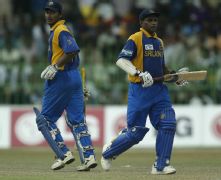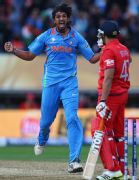|
A branch for cricket's expansion; a bloated, pointless tournament; a World Cup warm-up; a test of the best; a dead man walking; the Champions Trophy has had more identities than a CIA convention. Here is a history through seven matches that reveal most about them. 1998: A cracker in Bangladesh
Zimbabwe v New Zealand, October
So much about the tournament's uneven, thin history makes sense if we remember back to the first match played in its name. Also, the name: it wasn't the Champions Trophy but the Wills International Cup, although Wisden gave it some gravitas by calling it the Mini World Cup. The idea for the tournament came from the sharp mind of the spiritual father of modern Indian cricket administration, Jagmohan Dalmiya. The tournament was created to raise funds and to spread cricket beyond its closed Test-playing world. That was reflected in its location: Bangladesh may have been third on the list, but only behind other outlandish outposts such as Disney World in Florida, and Sharjah. The accent was on money-making - Bangladesh themselves weren't allowed to enter - and to generate revenues in the long four-year gaps between World Cups. It made US$10 million, a big deal for the ICC as it started to take control of its events. Some bright spark thought opening with Zimbabwe v New Zealand was a good move. They got this crackerjack of a game, won off the last ball with a four through extra cover by Chris Harris. That was the exclamation point on a chase that saw 40 taken from the last three overs. But it was played out to a half-empty stadium in Dhaka, which, in that cricket-obsessed nation, was some feat of administrative ineptness. And so a pattern was set - an event that gave us some fine cricket, if only we could be bothered watching it. 2000: Out of Africa
Kenya v India, October
If they had previously paid lip service to growth, this time the ICC seemed serious. Now called the ICC Knockout, not only was the tournament staged once again in cricket's developing world - Kenya - but both Bangladesh and Kenya were invited to play. That seemed to speak unequivocally of how the ICC expected this tournament to evolve. Kenya had beaten India in an ODI two years before this game, and not long after, would reach the semis of the World Cup; they were a decent investment for expansion. They were convincingly brushed aside in this opener at the Gymkhana Ground in Nairobi, though. Ravi Shah and Maurice Odumbe put together a partnership of some promise, but once Shah fell, the momentum petered out. A top order featuring Sourav Ganguly, Sachin Tendulkar, Rahul Dravid and Vinod Kambli were never going to be troubled by a paltry chase of 209, and so it proved.  By and large, however, the tournament worked. The ICC made an effort - their pitch consultant Andy Atkinson was sent out a few months in advance to spruce up sluggish pitches, and they were excellent for 50-over cricket. The ground was given a facelift. And they ended up making more money than before - $13 million. But there were also clear signs of how difficult a task spreading the game could be. Attendances were low throughout - 4000 for this game, far less for others. And both the games involving the hosts and Bangladesh were mismatches. 2002: Two finals, many questions
Sri Lanka v India, September
Around this time, as it finally found the right name, the predominant Champions Trophy theme began to form: what was the point of it? And much of that bewilderment was encapsulated by the denouement. Somehow, an 18-day tournament featuring 12 teams, failed to produce a clear winner. Two finals were attempted on successive days between the hosts and India, and monsoon rains let neither be completed. The pair had thus to be content sharing the trophy. In an immediate sense, it was a great shame, because both games were tantalisingly poised. In both Sri Lanka batted first and did so gamely on a pitch that was becoming slower by the over. In both, Virender Sehwag provided a brief but chilling portent of what he could have done before the rains came. The games were the ellipses to the end of the tournament rather than the exclamation point it needed. And they brought out all the frustrations that were building. Why, for instance, was it scheduled so thoughtlessly, just before the start of what is Sri Lanka's second monsoon season? Why was it taking place mere months before the flagship ICC event, the World Cup, in the process devaluing both events? Why were there so many teams playing in it, if it wasn't the World Cup and if - as in new invitee Netherlands' case - the quality of competition was so reduced? Why, why, why? 2004: Candy from babies
Australia v USA, September
In less than three embarrassing hours for pretty much everyone involved, the dream - or pretence, depending on whether you were a cynic or romantic - died. Until this game, expansion was a priority on the Champions Trophy agenda. The ICC kept the tournament bloated, with 12 teams; USA took the place of Netherlands, bringing into sharper focus the idea that the US was a market waiting to be broken into. Ricky Ponting's plan was to win the toss and worry about a washout in his next game - that's how irrelevant the opponents were here. Duly, USA were bowled out for 65, though they managed to prolong their painful collapse over 24 overs. Australia chased down the target in less than eight overs, in what remains one of the greatest mismatches in ICC history. After the game, Ponting questioned the value of including teams such as the US - and even Bangladesh - in such tournaments.  Those comments were, effectively, the start of a modern cricket conversation that has taken place at every 50-overs ICC tournament since, and shown up the flimsiness of the ICC's "dream" in the process. What price expansion? To what end? For more of these matches? And is expansion through exposure in such tournaments the best way? And if not, then what is the point of the Champions Trophy? 2006: What's the point?
West Indies v Zimbabwe, October
The dream may have died, but the ICC was still rubbing its eyes awake. Instead of removing mismatches altogether, they just moved them to before the tournament began, and called them qualifiers. This unwieldy format placed them halfway between what the tournament had begun as, and what it would finally become: the top six teams made it to the tournament automatically and two from the bottom four would make it after this qualifier. Zimbabwe were still in the throes of their administrative crisis and were no match for a West Indies side that could still rouse itself for the odd occasion. Jerome Taylor and Ian Bradshaw throttled them at the start, and it went downhill swiftly. Chris Gayle finished with 3 for 3, an indicator of the quality of the batting. And then he was dropped twice in his 41, as West Indies strode to a nine-wicket win with more than 35 overs to spare. Not only was a game such as this still pointless, it was now consigned to a portion of the tournament that nobody really cared about, and it meant the championship dragged on for a month. Barely 5000 people turned up, in a Gujarat stadium with a capacity of over 50,000. Months before the tournament had begun, Lalit Modi - at the forefront of a growing rift between the BCCI and the ICC - had rung the first death knell of the tournament, claiming India would not participate again because it interfered with their home season. 2009: The right stuff
Australia v Pakistan, September
Two and a half years had passed since the last global 50-over competition. In that time, the world had changed: the IPL was two editions young (preceded by the Indian Cricket League) and the ICC itself had squeezed in two World T20s. Meanwhile, ODIs were like: "Hey, Sri Lanka, this is India. Seven ODIs? 'KBye." The 50-over format was under serious threat and to save it came the Champions Trophy, itself terminally ill by now. Trust cricket to solemnly bring the existential angst. And yet, this was one of the better tournaments, a shot of adrenaline for itself and the format. It was tight - just a fortnight long, played out in two venues within driving distance of each other, on good surfaces, in a country expert at holding global sporting events. All pretence of expansion was gone: the top eight teams duked it out, no pre-qualifiers, no room for the weak. It may not be immediately evident from the results, but there was some riveting cricket, played at a time when Australia's dominance was thought to be just a little shaky.  All that was good about it was captured in this low-scoring, slow-burning thriller, in which three teams had a stake. Australia won off the very last ball, edging out India for a place in the last four. The pitch in Centurion was slow (but three days earlier had been good enough for 624 runs) and Australia looked in control until the 32nd over. Then, Mohammad Asif, Rana Naved-ul-Hasan and Saeed Ajmal combined to cause a dizzying collapse of 6 for 47. Australia's cussedness eventually saw them home, and eventually to the title.
All that was good about it was captured in this low-scoring, slow-burning thriller, in which three teams had a stake. Australia won off the very last ball, edging out India for a place in the last four. The pitch in Centurion was slow (but three days earlier had been good enough for 624 runs) and Australia looked in control until the 32nd over. Then, Mohammad Asif, Rana Naved-ul-Hasan and Saeed Ajmal combined to cause a dizzying collapse of 6 for 47. Australia's cussedness eventually saw them home, and eventually to the title.
2013:
India v England, June
The ICC was so confident the Champions Trophy was dead that over a year before the tournament they decided this was the last one. In fact, the 2013 tournament wasn't even supposed to have happened - this, remember, was supposed to be a Test championship playoff. Look what's still around and what still hasn't happened, though. This tournament had barely ended before administrators were considering one more after all. The format was unchanged from 2009. Twelve of the 15 games were officially sold out and the cricket wasn't bad (which might one day make for a decent epitaph for the tournament). But the irony of the final was too difficult to ignore. For one, in an effort to be short, sharp and sweet, the organisers had no reserve day planned (in England, always a rain check) for the final, which, at one stage, might have led to a repeat of 2002. Somehow a game was arranged but reduced to - wait for it - 20 overs. The final of a tournament under gravest threat from T20 forced to switch, as a last resort, to 20 overs: literally, you cannot make this up. At least it was a compelling game, decided by an audacious - or plain fortuitous - move by MS Dhoni in the 38th over. Against all reason he brought on the hitherto expensive Ishant Sharma; having conceded a six and two wides, Sharma took two key wickets to change the game. India, the spiritual birthplace of T20 cricket, ended as fitting winners.
|
